Latin name
Lethrinus miniatus
Other names
Redthroat emperor, sweetlip emperor, Sweetlip Swoose, island snapper, yellowmouth perch, yellowmouth snapper, lipper, nannygal
Identification
Lethrinus miniatus has the species name miniatus, meaning 'bright red' or 'scarlet', alluding to the reddish colour of the lips and/or the bright red colour sometimes visible between the spines of the dorsal fin.
This species is characterised by the following features: body moderately deep, dorsal profile slightly convex near the eyes, muzzle moderately long. Muzzle height 0.9-1 times greater than cheek height, dorsal profile slightly concave, angle of muzzle to maxilla from 50° to 65°, interorbital space from convex to flat. Posterior nostril - elongated opening closer to orbit than anterior nostril. Eye close to dorsal profile, cheek moderately high, lateral teeth in jaws conical, external surface of upper jaw smooth or with longitudinal protuberance. No scales on cheeks. 46-48 lateral line scales. 4 and a half rows of scales between lateral line and base of spines on mid dorsal fin. Inner surface of pectoral fins partially or densely scaled, posterior corner of gill cover completely scaled.
Features of fish fins
Dorsal spines (total): 10. Dorsal soft rays (total): 9. Anal spines: 3. Anal soft rays: 8. The 3rd dorsal fin is usually the longest. 13 pectoral fin rays.
Fish colouring
Body colour varies from silvery to light greyish brown. The head has a reddish tinge. Sometimes with 8-9 darker vertical stripes on the body. The base of the pectoral fin is bright red; the fins are pale to reddish, except for the spiny parts of the dorsal and anal fins, which are bright red. A red stripe often runs from the snout to the upper eyelid. They usually have reddish lips and the centre of each scale is usually dark.
Distribution
Occurs in the eastern Indian and western Pacific Oceans. In Australia, the species is found from Cape Freycinet in Western Australia north and east along the coast to Sydney. It is also found in the Philippines, the Ryukyu Islands and New Caledonia.
Habitat
A marine, tropical species. Depth range from 5 to 30 metres. Adults spend the day on coral reefs, rarely venturing out onto sandy and rubble areas between coral thickets to feed. At night they leave the reef for sandy areas where they hunt actively. Juveniles are found in algae and mangroves, preferring shallower waters close to shore.
Size
The maximum published total length of this species is 90 cm (35 inches), although 40 cm (16 inches) is more typical. Maximum reported weight: 9.6 kg. Maximum reported age: 22 years.
Behavior
Occur in small flocks. Do not migrate. At night they move along the sandy seabed, actively foraging for food.
Food and feeding habits
A predatory species that feeds on crustaceans, molluscs, echinoderms and fish, especially crabs and sea urchins.
Reproduction
This species is a protogynous hermaphrodite (female first, then male).
Fishing
Fished with hand line and drop shot rods. Important commercial species in New Caledonia. Dominates the fishery off Norfolk Island.
Relationship with a person
Widely used as a commercial and food fish on the Great Barrier Reef. The species has been linked to cases of ciguatera poisoning.
| Classification | |
| Phylum | Chordata |
| Class | Actinopterygii |
| Squad | Spariformes |
| Family | Lethrinidae |
| Genus | Lethrinus |
| Species | L. miniatus |
| Features | |
| Conservation status | Least Concern |
| Habitat | Pelagic |
| Life span, years | 22 |
| Maximum body weight, kg | 9,6 |
| Maximum length, cm | 90 |
| Sailing speed, m/s | No information |
| Threat to people | Edible |
| Way of eating | Predator |
Trumpet emperor
Tags: trumpet emperor

